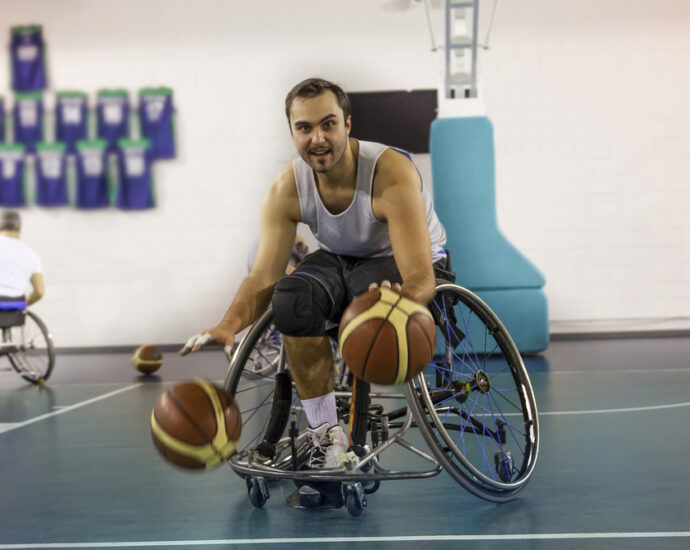Maintaining muscle tone for individuals in wheelchairs is crucial for overall health and well-being. There are several strategies and exercises that can help keep muscles strong and toned, even with limited mobility. Over 1 million older adults will end up in wheel chairs.
Here are some effective methods:
-
Upper Body Exercises
- Resistance Training: Using resistance bands or light weights to perform exercises such as bicep curls, shoulder presses, and tricep extensions can help maintain upper body strength.
- Wheelchair Push-Ups: Placing hands on the armrests and lifting the body slightly can help strengthen the chest, shoulders, and triceps.
- Seated Rows: Using a resistance band or pulley system to perform rowing motions helps strengthen the back and shoulder muscles.
-
Core Exercises
- Seated Leg Lifts: Lifting one leg at a time while seated helps engage the core muscles.
- Seated Marching: Alternating lifting knees towards the chest while seated to activate the abdominal muscles.
- Twists: Holding a lightweight object, twist the torso from side to side to work the obliques.
-
Range of Motion Exercises
- Arm Circles: Extend arms to the side and make small, controlled circles to maintain shoulder flexibility.
- Neck Stretches: Gently tilt the head from side to side and front to back to keep the neck muscles flexible.
- Shoulder Shrugs: Raise shoulders towards the ears and then relax them down to maintain shoulder mobility.
-
Leg and Foot Exercises
- Seated Leg Extensions: Extend one leg at a time, straightening the knee, to engage the quadriceps.
- Ankle Pumps: Flex and point the toes to maintain ankle flexibility and circulation.
- Calf Raises: While seated, lift heels off the ground to engage the calf muscles.
-
Adaptive Sports and Activities
- Wheelchair Sports: Participating in sports such as wheelchair basketball, tennis, or racing can provide a full-body workout and improve muscle tone.
- Swimming: Adaptive swimming programs allow for a low-impact, full-body workout that can help maintain muscle tone.
-
Physical Therapy
- Customized Exercise Plans: Working with a physical therapist to develop a personalized exercise plan tailored to individual needs and capabilities.
- Electrical Stimulation: Using electrical stimulation devices to contract muscles and maintain tone in those with limited voluntary movement.
-
Daily Activities
- Self-Propulsion: Pushing the wheelchair manually instead of using an electric option can help maintain arm and shoulder strength.
- Transfers: Practicing safe and effective transfer techniques can help maintain muscle strength and coordination.
-
Nutrition
- Balanced Diet: Consuming a diet rich in protein, vitamins, and minerals to support muscle health and overall well-being.
- Hydration: Staying hydrated to help maintain muscle function and prevent cramps.
-
Mind-Body Practices
- Yoga and Stretching: Adaptive yoga and stretching exercises can help maintain flexibility, strength, and relaxation.
- Breathing Exercises: Practicing deep breathing exercises to enhance lung capacity and core strength.
Conclusion
Maintaining muscle tone for individuals in wheelchairs involves a combination of targeted exercises, adaptive sports, physical therapy, and a balanced diet. These practices not only help keep muscles strong and toned but also improve overall health, mobility, and quality of life. Always consult with a healthcare provider or physical therapist to develop a safe and effective exercise routine tailored to individual needs.
Health Benefits Of Toned Muscles
Toned muscles provide numerous health benefits that contribute to overall well-being and quality of life. Here are some key advantages of having toned muscles:
- Increased Caloric Burn: Toned muscles have a higher metabolic rate, meaning they burn more calories at rest. This helps in weight management and reducing body fat.
- Physical Performance: Toned muscles improve overall strength and endurance, making daily activities and physical tasks easier to perform.
- Athletic Performance: Enhanced muscle tone contributes to better performance in sports and exercise, allowing for more effective workouts and quicker recovery.
- Posture: Strong, toned muscles support proper alignment of the spine and joints, reducing the risk of back pain and improving posture.
- Balance: Toned muscles enhance stability and balance, which helps prevent falls and injuries, especially in older adults.
- Joint Stability: Toned muscles provide better support for joints, reducing the risk of joint injuries and conditions such as arthritis.
- Pain Management: Strengthened muscles can alleviate chronic pain conditions, including lower back pain and knee pain, by reducing the strain on joints and other structures.
- Bone Health: Weight-bearing exercises that tone muscles also strengthen bones, reducing the risk of osteoporosis and fractures.
- Heart Health: Regular exercise that tones muscles can improve cardiovascular health by lowering blood pressure, improving circulation, and reducing the risk of heart disease.
- Stress Reduction: Exercise that tones muscles releases endorphins, which help reduce stress and improve mood.
- Cognitive Function: Physical activity has been linked to better cognitive function and a lower risk of cognitive decline.
- Insulin Sensitivity: Toned muscles improve the body’s sensitivity to insulin, helping to regulate blood sugar levels and reduce the risk of type 2 diabetes.
- Immune Health: Regular physical activity that promotes muscle tone can boost the immune system, making the body more resilient to infections and illnesses.
- Muscle-to-Fat Ratio: Toned muscles contribute to a healthier body composition by increasing the muscle-to-fat ratio, which is beneficial for overall health and appearance.
- Sleep Improvement: Regular exercise that tones muscles can improve sleep quality by helping regulate sleep patterns and reducing insomnia.
Toned muscles offer a wide range of health benefits, from improved metabolism and physical performance to enhanced mental well-being and disease prevention. Incorporating strength training and regular exercise into your routine can help you achieve and maintain toned muscles, leading to a healthier, more active, and fulfilling life.
READ MORE: Stretch Your Way to Better Health: Why Stretching is Essential for Fitness
Sources:
https://hurusa.com/how-to-support-a-healthy-range-of-motion-in-wheelchair-bound-seniors/
https://www.disabilityfriendlylv.com/21-Best-Wheelchair-Sports-You-Need-to-Know/
https://healthsurgeon.com/purium-products/dark-berry-protein/
https://www.bodybalancelifestyle.com/blog/benefits-of-body-toning
